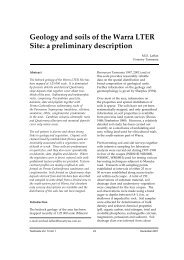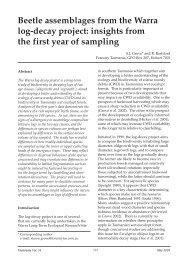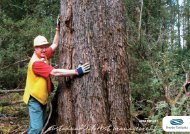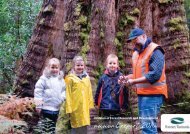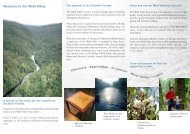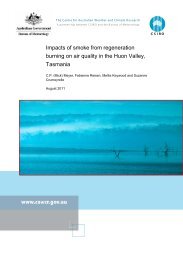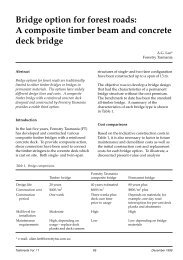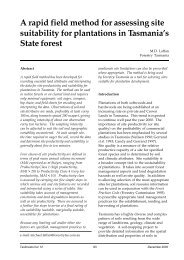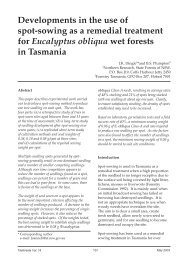The natural distribution of Eucalyptus species in Tasmania - Forestry ...
The natural distribution of Eucalyptus species in Tasmania - Forestry ...
The natural distribution of Eucalyptus species in Tasmania - Forestry ...
Create successful ePaper yourself
Turn your PDF publications into a flip-book with our unique Google optimized e-Paper software.
comparatively high level <strong>of</strong> <strong>in</strong>traspecific<br />
variation, and Shaw et al. (1984) suggest that<br />
populations tend<strong>in</strong>g towards E. coccifera on<br />
mounta<strong>in</strong>s with<strong>in</strong> the range <strong>of</strong> E. nitida are<br />
probably remnants <strong>of</strong> upslope migration<br />
s<strong>in</strong>ce the last glacial. <strong>The</strong>y suggest that the<br />
restricted <strong>distribution</strong> <strong>of</strong> E. coccifera <strong>in</strong> the<br />
west may be due to limited migration s<strong>in</strong>ce<br />
that time from a south-eastern refuge.<br />
On the Central Plateau, Eastern Tiers and<br />
mounta<strong>in</strong>s <strong>of</strong> the south, E. coccifera generally<br />
occurs above 800 m to the tree-l<strong>in</strong>e (up to<br />
1290 m at Drys Bluff). On isolated mounta<strong>in</strong>s<br />
<strong>of</strong> the south-east, it occurs at the lower<br />
altitude range <strong>of</strong> 390 m to 800 m (cf. Figure 16).<br />
It is also found at these lower altitudes along<br />
the western marg<strong>in</strong>s <strong>of</strong> its range where it<br />
<strong>in</strong>tergrades with E. nitida. <strong>The</strong> ma<strong>in</strong> flower<strong>in</strong>g<br />
Figure 16. Altitude <strong>distribution</strong> <strong>of</strong> E. coccifera.<br />
n = 56<br />
Figure 17. Flower<strong>in</strong>g times for E. coccifera.<br />
n = 326<br />
period is November to February, peak<strong>in</strong>g<br />
through December and January (Figure 17).<br />
<strong>Eucalyptus</strong> coccifera is a widespread dom<strong>in</strong>ant<br />
<strong>of</strong> low, shrubby forests and woodlands <strong>in</strong><br />
subalp<strong>in</strong>e environments (Photo 6). <strong>The</strong> form<br />
is generally poor, rang<strong>in</strong>g from a forest tree<br />
with low, spread<strong>in</strong>g branches to a twisted and<br />
gnarled mallee with attractively red-streaked<br />
bark as exposure <strong>in</strong>creases. It frequently<br />
forms pure stands, but a <strong>species</strong> from the<br />
series Vim<strong>in</strong>ales (i.e. E. dalrympleana, E. rubida,<br />
E. archeri, E. gunnii, E. urnigera, E. subcrenulata<br />
or E. johnstonii) may sometimes be present and<br />
subdom<strong>in</strong>ant, depend<strong>in</strong>g upon the geographic<br />
location. In topographic situations that are<br />
generally protected from the climatic<br />
extremes, E. coccifera shrubby woodlands<br />
merge <strong>in</strong>to E. delegatensis open forest.<br />
COMMENTS: Apart from the <strong>in</strong>tergradation<br />
between E. coccifera and E. nitida along the<br />
western geological divide, isolated stands<br />
<strong>of</strong> E. coccifera <strong>in</strong> the east may hybridise or<br />
<strong>in</strong>tergrade with the lowland pepperm<strong>in</strong>ts<br />
E. pulchella, E. amygdal<strong>in</strong>a and E. tenuiramis. For<br />
example, the population <strong>in</strong>cluded here from<br />
Alma Tier (cell 5033) is <strong>in</strong>termediate between<br />
E. tenuiramis and E. coccifera (Shaw et al. 1984;<br />
Wiltshire et al. 1991a, 1992) and, on Snug<br />
Pla<strong>in</strong>s (cell 5122), hybrids between E. pulchella<br />
and E. coccifera result from an unusual juxtaposition<br />
<strong>of</strong> these <strong>species</strong> (Davidson et al.<br />
1987). Intermediates between E. coccifera<br />
and E. tenuiramis have been reported from<br />
exposed coastal situations on Tasman<br />
Pen<strong>in</strong>sula (e.g. cells 5722, 5723, 5822),<br />
Cape Deslacs (Kitchener 1985), and <strong>in</strong> some<br />
populations on Bruny Island (Wiltshire et al.<br />
1991a). A putative record for E. coccifera<br />
on McGregor Peak (cell 5724) needs field<br />
verification to determ<strong>in</strong>e whether a pure<br />
population <strong>of</strong> E. coccifera does actually exist<br />
<strong>in</strong> the Forestier – Tasman Pen<strong>in</strong>sula region.<br />
However, recent work on the relationships<br />
among the pepperm<strong>in</strong>ts by analysis <strong>of</strong> leaf<br />
oils (Li et al. 1995) suggests that 'typical'<br />
E. coccifera has closer aff<strong>in</strong>ities with E. nitida<br />
than with E. tenuiramis. Similarly, a record for<br />
E. coccifera from Freyc<strong>in</strong>et Pen<strong>in</strong>sula (cell 6033)<br />
is also likely to represent a misidentification<br />
Tasforests Vol. 8 59<br />
December 1996




